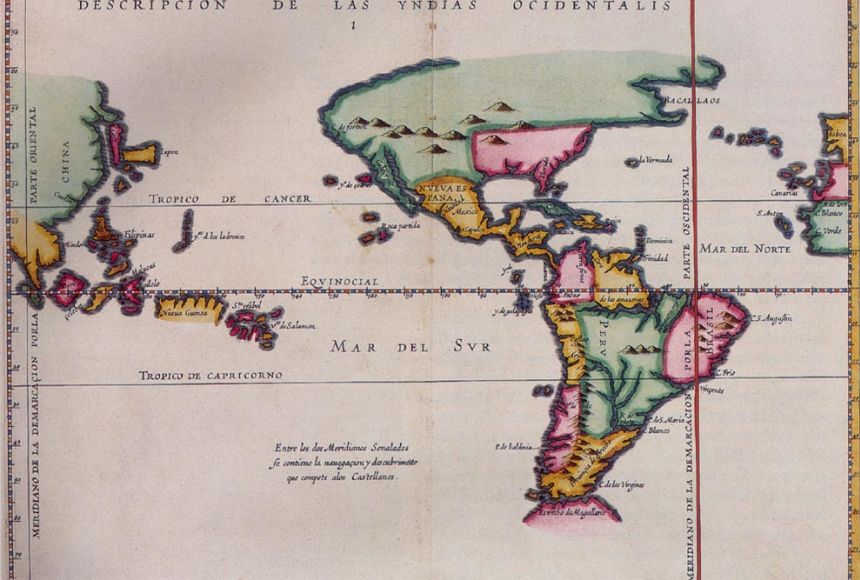It’s hard to imagine a time when the U.S. was just a pawn in another country’s machinations. But that was exactly what happened in the Treaty of Tordesillas, which was signed on June 7, 1494.
Back then, there was no United States of America. Instead, there was a “New World” and it was to be divided between two superpowers, Spain and Portugal.
Let’s take a look at the events leading to the Treaty of Tordesillas and its impact on the world.

Background
It’s hard to determine the oldest country in the world because there are different criteria. However, Portugal is considered the oldest nation in Europe based on when it set up its borders sometime in 1139 BCE. Portuguese explorers traveled the world and colonized Atlantic islands in the 1400s.
Not to be outdone, Spain, which already had a larger territory than Portugal, also set off to conquer territories around the world. By the 1500s, Spain had become a dominant European power.
It all started when Italian explorer Christopher Columbus reached the Americas on a voyage sponsored by the Crown of Castile, which was the most powerful kingdom in the Iberian Peninsula at that time. He departed Palos de la Frontera on August 3, 1492, with three ships under his command, the Santa Maria, Pinta, and Niña.
The voyage reached the following lands:
- Bahamas
- Cuba
- Hispaniola
- Haiti
- Dominican Republic
All along Columbus thought he had reached Asia, which was always his intended destination, not the Americas. When Columbus wrote a letter to the Spanish court about his discovery, King Ferdinand II and Queen Isabella I of Castile and Aragon immediately sought papal support to prevent Portugal from interfering with their claim on the New World.
Pope Alexander VI responded positively with papal bulls that set up a demarcation line about 100 leagues or 320 miles west of Cape Verde Islands. Based on the papal bulls, Spain had exclusive rights over newly discovered and yet-to-be-discovered lands west of the line.
Columbus’ letter to the Spanish crown spread like wildfire throughout Europe. Plus, Columbus also stopped by Lisbon before returning to Spain. He spoke to Portuguese King John II about the islands southwest of the Canary Islands.
King John II was miffed when he heard about the papal bulls because these implied that Portuguese exploration would have to be limited to the east of the line. It did not sit well with Portugal as it left the country with little leeway to continue the exploration of Africa.
In a threatening letter to the Spanish monarchs, King John II said that all the islands that Columbus discovered belonged to Portugal by virtue of the Treaty of Alcacovas.
What Is the Treaty of Alcacovas?
Before Columbus’ exploration, there was already an agreement between Castile and Aragon on one hand and Portugal on the other regarding the distribution of territories. Castile and Aragon were two provincial kingdoms in Spain. Representing Spain were the Catholic Monarchs of Castile and Aragon while Portugal authorized then-Prince John.
The Treaty of Alcacovas treated many disputes that involved different groups. One of the issues it dealt with was the agreement signed on September 4, 1479. It divided the Atlantic Ocean into two zones of influence.
Under the earlier treaty, Portugal owned most of the disputed territories. Castile had rights over the Canary Islands while Portugal had navigation rights over all Atlantic Ocean territories south of the Canary Islands.
To settle the renewed territorial dispute, the parties met in Tordesillas.
The Treaty of Tordesillas
The Spanish town of Tordesillas was the venue for the meeting between the leaders of Spain and Portugal. Together, they would decide on the delineation of territories.
The Treaty of Tordesillas followed the principle of dividing the New World territories. Western territories were given to Portugal and the eastern territories went to Spain. However, they amended Pope Alexander VI’s demarcation line to make things fairer for both parties.
On June 7, 1494, ambassadors and barristers representing King Ferdinand II and Queen Isabella on one side and King John II on the other met in Tordesillas. After much discussion, the demarcation line was moved to 370 leagues to the west of Cape Verde Islands.
For those wondering why Brazilians speak Portuguese, the Treaty of Tordesillas is the answer. It fell within the territories of Portugal while most of the other Latin American countries spoke Spanish.
What Portugal was really protecting in the Treaty of Tordesillas was the route that led to India.
The border wasn’t strictly enforced and Spain didn’t try to contradict Portugal when it expanded Brazil across the meridian. It was hard to be strict with demarcations when it was only mentioned in the agreement. The parties also didn’t know the exact circumference of the earth. The best way to fairly divide the assets was through a joint exploration. However, the planned joint voyage never happened.
Treaty of Zaragoza
As both nations continued their exploration and discovery of the world, they realized the need to amend the earlier Treaty of Tordesillas.
The Treaty of Zaragoza was another peace agreement between Castile and Portugal signed on April 22, 1529, or close to 35 years since the agreement in Tordesillas. This time, the treaty established the superpowers’ territories in Asia.
It all started when Portugal conquered the city-state of Malacca in 1511 and established a trading route that included the Maluku Islands or the Spice Islands. It was called the Spice Islands because of the cloves, mace, and nutmeg that exclusively grew in the area at that time. Portugal controlled the spice trade in the Spice Islands. Spain got wind of the activities because it was also exploring Asia.
Between 1525 and 1528, both countries explored the areas surrounding those islands. More territories were discovered in the process. During this time, Portugal was ruled by King John III while Spain was ruled by King Charles V who was concurrent Holy Roman Emperor and Archduke of Austria.
Instead of continuing to fight over territories, the two parties chose to form alliances through marriage and treaties. King John III married King Charles V’s younger sister, Catherine of Austria on February 10, 1525. King Charles V also married King John III’s sister, Isabella of Portugal on March 11, 1526.
The Treaty of Zaragoza was signed on April 22, 1529, with the two kings representing their countries.
The Agreement
Under the Treaty of Zaragoza, the demarcation line was 297.5 leagues east of the Maluku Islands. The islands remained under Portuguese control in exchange for 350,000 gold ducats, the European currency at that time. Since both parties were friendly with one another, there was a clause that the agreement could be revoked if either of them wished and the money would be refunded.
The treaty was never revoked because Charles V needed the money as Austria and Spain were in the middle of the War of the League of Cognac. It didn’t even matter that the portion was purportedly unequal. Portugal controlled almost all of Asia, at least, those that were discovered at that time. Spain had most of the Pacific Ocean.
While the Philippines was not implicitly mentioned in the treaty, it was supposed to be west of the line, which means that it belonged to Portugal. However, Spain successfully established control over the country without opposition from Portugal because of the lack of spices in the Philippines.
Treaty of Madrid
Just as they established a solid agreement with the Treaty of Zaragoza, another treaty was signed on January 13, 1750, 271 years since the first agreement in Alcacovas.
The Treaty of Madrid erased the demarcation lines established in the earlier Treaties of Tordesillas and Zaragoza. The 1750 treaty settled many disputes:
- It established boundaries between Portuguese Brazil and Spanish colonial territories in Latin America.
- Spain agreed to the Brazil expansion fixed by Portugal.
- Portugal recognized Spain’s claim to the Philippines
- Both parties agreed to support each other in case a third power attacked or conquered their American colonies
Treaty of Tordesillas on Display
The United Nations Education, Scientific, and Cultural Organization or UNESCO has preserved the Treaty of Tordesillas through its Memory of the World Programme. The original copies of the treaty are stored at the General Archive of the Indies in Spain and the Torre do Tombo National Archive in Portugal.
What Is the Relationship Between Spain and Portugal Today?
Based on the treaties mentioned, Spain and Portugal had a hot and cold relationship that was akin to sibling rivalry. While both are located in the Iberian Peninsula, each has distinct characteristics. Spain is geographically larger than Portugal by a large margin. As the bigger sibling, Spain was somewhat condescending toward its smaller sibling.
As a Washington Post article from 1983 read, “Spaniards display the same kind of condescension toward Portugal that the French show toward Spain: a big-brother attitude toward a smaller, more backward neighbor.”
While Spain and Portugal will always have a rivalry, they continue to deepen their bilateral relations. They are no longer in conflict and there will never be another Treaty of Tordessilas that sets demarcation lines again. Besides, Spain and Portugal are no longer the superpowers they used to be.

